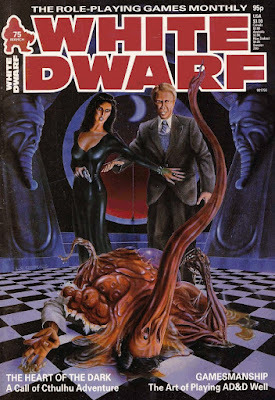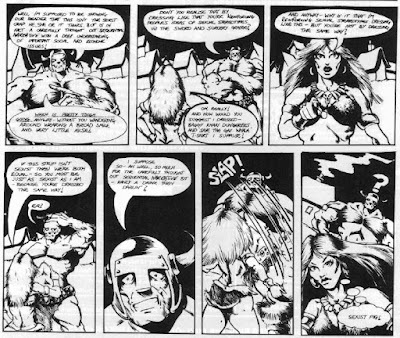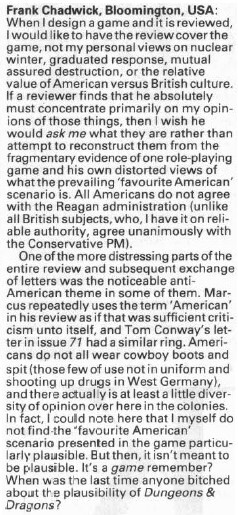White Dwarf: Issue #75
 Issue #75 of White Dwarf (March 1986) sports a horror – or I should I say Call of Cthulhu? – themed cover by Lee Gibbons, whose work appeared several times in the past few months, most notably issue #72. This issue marks a changing of the guard at the magazine, with Ian Marsh taking over its reins from Ian Livingstone. In his inaugural editorial, Marsh admits to "an element of trepidation" about his new job, especially at a time when WD is "mutating slowly into a different beastie." He elaborates on this, explaining that there is a "shift away from the usual formulaic style" of the magazine, by which I think he means an end to the regular, monthly columns and other features that have defined its content since the beginning. Regardless, the times, they are a'-changin' at the Dwarf.
Issue #75 of White Dwarf (March 1986) sports a horror – or I should I say Call of Cthulhu? – themed cover by Lee Gibbons, whose work appeared several times in the past few months, most notably issue #72. This issue marks a changing of the guard at the magazine, with Ian Marsh taking over its reins from Ian Livingstone. In his inaugural editorial, Marsh admits to "an element of trepidation" about his new job, especially at a time when WD is "mutating slowly into a different beastie." He elaborates on this, explaining that there is a "shift away from the usual formulaic style" of the magazine, by which I think he means an end to the regular, monthly columns and other features that have defined its content since the beginning. Regardless, the times, they are a'-changin' at the Dwarf."Open Box," for example, consists almost entirely of reviews of Games Workshop products, starting with the Supervisors Kit for Golden Heroes (8 out of 10) and Terror of the Lichemaster (9 out of 10) for use with Warhammer. There's also a review of Judgment Day (9 out of 10), an adventure for Judge Dredd – The Role-Playing Game. Rounding out the GW products covered this issue is its edition of the venerable science fiction boardgame Cosmic Encounter (also 9 out of 10 – I'm sensing a theme here). Finally, there's a look at Chaosium's second Call of Cthulhu companion, Fragments of Fear, which earns 7 out of 10. While it's inevitable that a periodical published by a company involved in the industry it's covering will include reviews of products it also publishes – TSR's Dragon certainly did – I nevertheless can't help but feel a line was crossed this issue, given the preponderance of Games Workshop releases reviewed. Perhaps next issue will be better?
I feel like a bad person for only enjoying Dave Langford's "Critical Mass" when he snarks about books about books and authors I, too, dislike. This month he brings the hammer down on the Darkover novel, Hawkmistress:
There will no doubt be hordes more 'Darkover' tales from Marion Zimmer Bradley: publishers love issuing books very similar to previous ones. Hawkmistress ... despite its veneer of science-fantasy, seems hauntngly familiar. Heroine Romilly wears breeches and gets on well with animals, but Daddy wants her to don girlish clothes and marry. One knows instantly that the chap Romilly finds most loathsome is Daddy's intended bridegroom: and so it proves. With hawk and horse our heroine to find her way in the world.The interesting thing about Langford's critique of the novel is not that he thinks it's bad – he calls its "a readable yarn" – but that it is essentially a romance novel in very thin science fantasy dress, which I think is a fair criticism of her oeuvre (and that of Anne McCaffrey, come to think of it).
"Getting the Fright Right" is this month's installment of Colin Greenland's "2020 Vision" column. It's a collection of reviews of then-current horror movies, broadly defined, ranging from The Return of the Living Dead to Fright Night to Teen Wolf. Greenland's reviews of these films is interesting, because, as the article's title suggests, he takes some time to talk about the proper balance of thematic elements within a horror movie to make it enjoyable for him. I like this approach to reviews, since, even when I disagree with them, I at least understand where the reviewer is coming from and that's quite useful.
"Thrud Gets a Social Conscience" is this issue's installment of "Thrud the Barbarian," humorously addressing the claim that the comic (and, by extension, the entire genre of sword-and-sorcery) is sexist. This leads to an amusing exchange between Thrud and his occasional female guest star, Lymara the She-Wildebeest, about how her attire reinforces negative sexual stereotypes.
 There are also new installments of "Gobbledigook" and "The Travelles," but they're not nearly as amusing.
There are also new installments of "Gobbledigook" and "The Travelles," but they're not nearly as amusing.Oliver Dickinson's "RuneQuest Ruminations" is a look at the third edition of RQ (published by Avalon Hill) with a special focus on those parts of its rules that he found vexing or inadequate in some way. A lot of the article is very "inside baseball" to someone like myself whose experience with RuneQuest is limited. What most comes across, though, is how much of a shock and disappointment this edition of the game was to many of its long-time fans, particularly in the way that it downgraded Glorantha to the status of an afterthought.
"How to Save the Universe" by Peter Tamlyn is a lengthy and thoughtful look at "the delights of superhero gaming." Tamlyn's main point seems to be that there are a lot of different styles of play within superhero RPGs – more than enough to satisfy almost every preference. Consequently, one should not dismiss the entire genre as "kid's stuff." "Gamesmanship" by Martin Hytch is an oddly titled but similarly lengthy and thoughtful look at "injecting a little mystery" back into AD&D adventures. The overall thrust of the article concerns the way experienced players treat so many of the game's challenges in a procedural fashion, quoting rules and statistics rather than entering into the fantasy of it all. It's difficult to summarize Hytch's advice in a short space; suffice it to say that it's mostly quite good and filled with useful examples. I may write a separate post about it, because I think he does an excellent job of addressing the many questions he raises.
"Mass Media" by Andrew Swift looks at the nature of communications technology at various tech levels in Traveller. It's fine for what it does but nothing special. On the other hand, Graeme Davis's "Nightmare in Green" AD&D adventure is phenomenal. Aimed at 4th–6th level characters, it concerns the threat posed a collection of nasty, plant monsters crossbred by a mad druid. I'm a big fan of plant monsters, so this scenario immediately caught my attention, all the more so since some of the monsters are inspired by the works of Robert E. Howard and Clark Ashton Smith.
That brings us to another highlight of this issue. You may recall that, back in issue #68, reviewer Marcus L. Rowland gave a very negative review to GDW's Twilight: 2000. This led to a flurry of letters in issue #73, both pro and con Rowland's review. With this issue, Frank Chadwick, designer of the game weighs in and he pulls no punches.
 "The Heart of the Dark" by Andy Bradbury is "an illuminatingly different" Call of Cthulhu scenario, because it does not directly feature any encounters with the Mythos or its associated entities. Indeed, the adventure includes no game statistics of any kind "since it is doubtful that they will be needed." This is a pure, roleplaying scenario filled with lots of investigation, social interactions, and red herrings. It's intended as a change of pace
"The Heart of the Dark" by Andy Bradbury is "an illuminatingly different" Call of Cthulhu scenario, because it does not directly feature any encounters with the Mythos or its associated entities. Indeed, the adventure includes no game statistics of any kind "since it is doubtful that they will be needed." This is a pure, roleplaying scenario filled with lots of investigation, social interactions, and red herrings. It's intended as a change of pace "Local Boy Makes Good" by Chris Felton looks at character background in AD&D, with lots of random tables for determining social class, birth order, father's profession, and so on. I suppose this could be of interest to others, but not to me. Finally, Joe Dever begins a new series on preparing and using oil paints for miniature figures. I know nothing about this topic; despite that, I find it weirdly fascinating, like all of Dever's articles in his monthly "Tabletop Heroes" column.
Issue #75 of White Dwarf continues the recent trend of feeling slightly "off" to my sensibilities. There's still plenty of excellent content, but there's also an increasingly detectable undercurrent of change and not for the better. Perhaps I am simply hypersensitive to this because I know that WD will soon be little more than a house organ for Games Workshop and I am constantly one the lookout for signs – any signs – of this imminent transformation. Regardless, I will keep plowing ahead, though, for how much longer, I don't yet know.
James Maliszewski's Blog
- James Maliszewski's profile
- 3 followers



